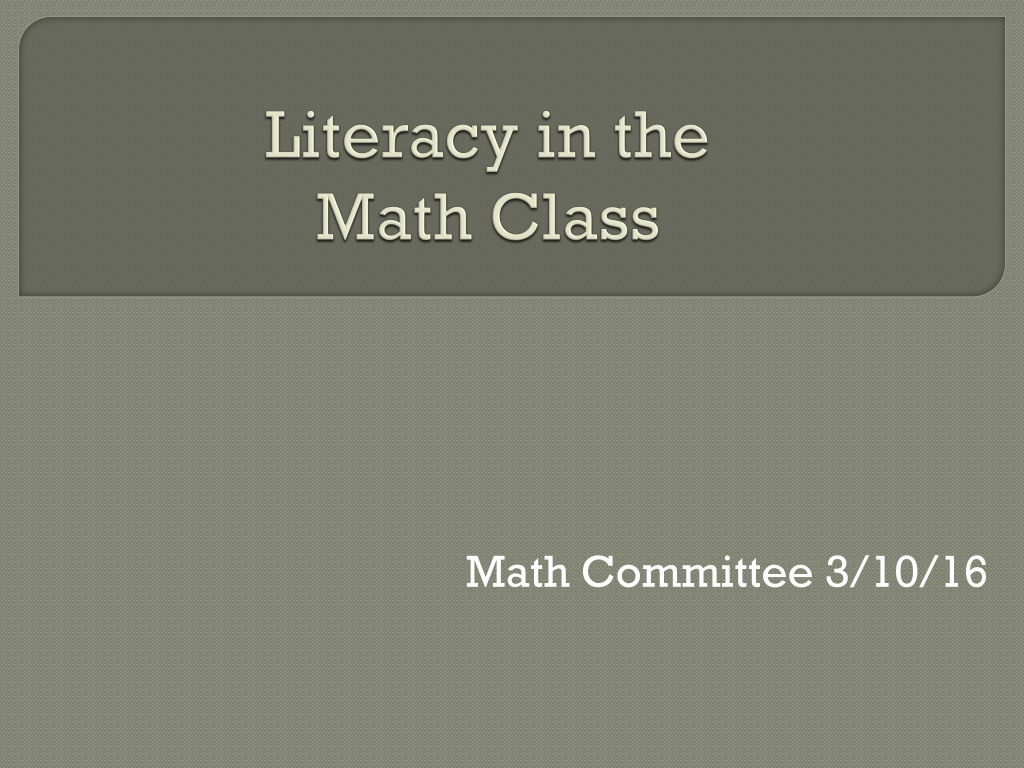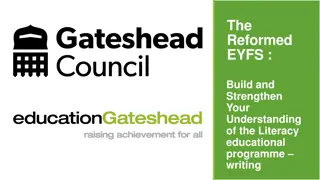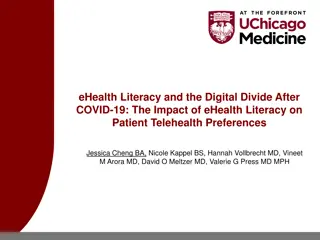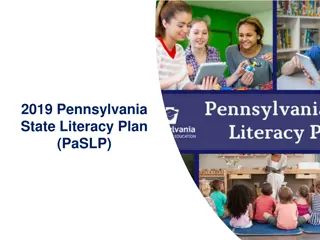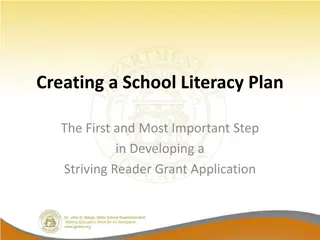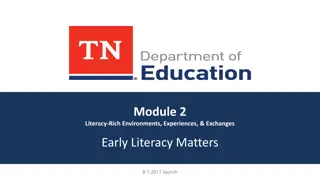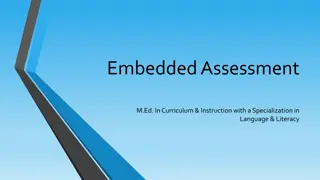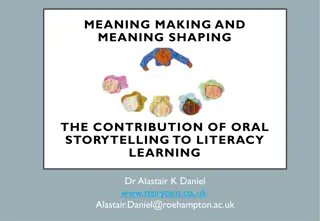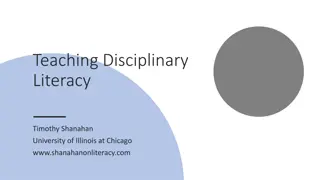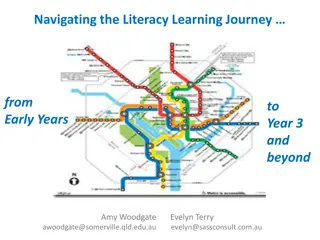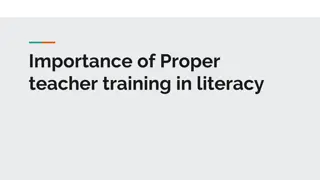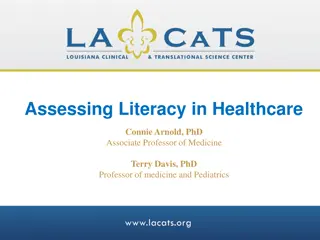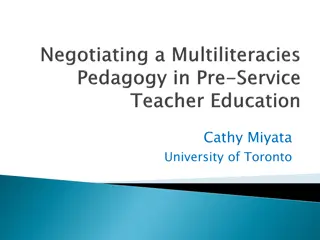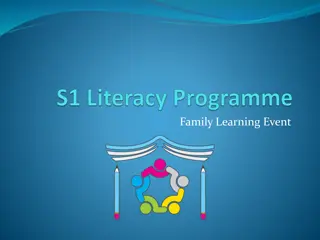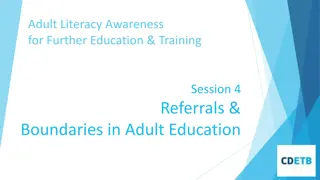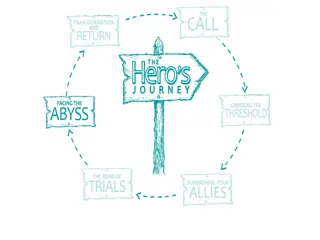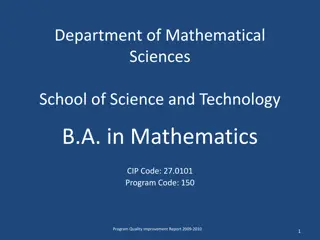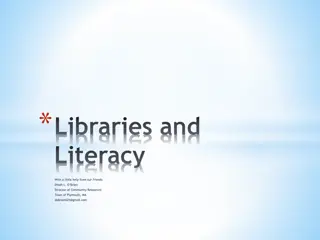Understanding Mathematical Literacy and Its Importance in Education
Recognizing the language of mathematics, understanding symbols, and being able to explain solutions are key components of mathematical literacy. It goes beyond merely answering questions correctly to encompass explaining reasoning and exploring concepts actively. The Standards for Mathematical Practice guide students in engaging with math effectively as they develop expertise. Mathematical literacy is essential for effective communication and problem-solving in the mathematical domain.
Download Presentation

Please find below an Image/Link to download the presentation.
The content on the website is provided AS IS for your information and personal use only. It may not be sold, licensed, or shared on other websites without obtaining consent from the author. Download presentation by click this link. If you encounter any issues during the download, it is possible that the publisher has removed the file from their server.
E N D
Presentation Transcript
What does it mean to be literate?
Acquisition and learning and how the combination of the two allows one to communicate Socially recognized ways of generating, communicating, and negotiating meaningful content through the medium of encoded text Code breaker, text participant, text user and text analyst Use and critically examine the text
What does it mean to mathematically literate?
Recognizing the language of mathematics and its symbols, understanding what is being represented, and being able to explain (through solving or words) how to solve the scenario presented. Steinhilber, pg. 4
Can we consider a student who missed zero questions on a worksheet literate if they cannot explain why they follow those steps or what happens if they mix them up?
The Standards for Mathematical Practice describe ways in which developing student practitioners ought to engage with the subject matter as they grow in mathematical maturity and expertise.
Mathematical Literacy: Recognizing the language of mathematics and its symbols, understanding what is being represented, and being able to explain (through solving or words) how to solve the scenario presented.
They can only do that by exploring, justifying, representing, discussing, using, describing, investigating, predicting, in short by being active in the world. Countryman, pg. 2
Writing mathematics can free students of the assumption that math is just a collection of right answers to questions posed by someone else Countryman, pg. 11
Helps students become aware of what they know and do not know Connect to prior knowledge Summarize their knowledge Raise questions about new ideas Reflect on what they know Construct math for themselves Countryman, pg 4-7
Journals Freewrite Learning logs Math autobiographies About math problems Formal papers Test questions
Writing to learn is different from writing to show that you have learned what the teacher or the text has set for you to learn. As you write, ideas come to you. Writing can be a way to find out what they know and what they don t know. Countryman, pg. 88
Think about what you are teaching next week. How will you have your students write to learn?
To support discourse effectively, teachers must build a community in which students will feel free to express their ideas. Thompson, pg. 44
Ideally, we would like students to present their thinking about problems they are trying to solve and have other students question, challenge, and debate what is offered. Thompson, pg. 48
Using a thinking-based curriculum The furniture arrangement is conducive to student talk Frequently use think-pair-share Ask questions Build on student responses Focus students on building meaning Make sharing your thinking part of the routine
Think about your learning environment. What can you change to encourage more math talk?
Word problems are an important part of mathematic instruction. They help students see how math might be used in the real world. However, many students struggle making sense of the problems they read. Thompson, pg. 53
Supports students independent meaning- making Offers opportunities to communicate in small groups Clarify understanding with whole group discussions Informally assess students understanding
Give students an opportunity to read independently Students take turns sharing what they understand Partners discuss similarities and differences to arrive at a consensus of what they think the problem mean
1) Think-Pair-Share 2) Zoom In
Guide the class as the students analyze the information in the problem Help students determine important and extraneous information Students should identify and clarify meaning of vocabulary
1) Think-Pair-Share 2) Zoom In 3) Zoom Out
Ask partners: What does the problem say What math is needed to solve What approaches might be useful If necessary lead class in a discussion on the process described for partners let all possibilities arise
1) Think-Pair-Share 2) Zoom In 3) Zoom Out 4) Solve
Students should solve the task with peers Construct a written explanation of the process used
1) Think-Pair-Share 2) Zoom In 3) Zoom Out 4) Solve 5) Group Share
Provide opportunities for students to illustrate different approaches in a whole-class setting The purpose is to Have students recognize the value of different methods Analyze the effectiveness and efficiency of different approaches
1) Think-Pair-Share 2) Zoom In 3) Zoom Out 4) Solve 5) Group Share
1) What parts of the Zoom-In-Zoom-Out might be the most challenging? 2) How might you modify this comprehension strategy for use in your class?
Recognizing the language of mathematics and its symbols, understanding what is being represented, and being able to explain (through solving or words) how to solve the scenario presented. Steinhilber, pg. 4
